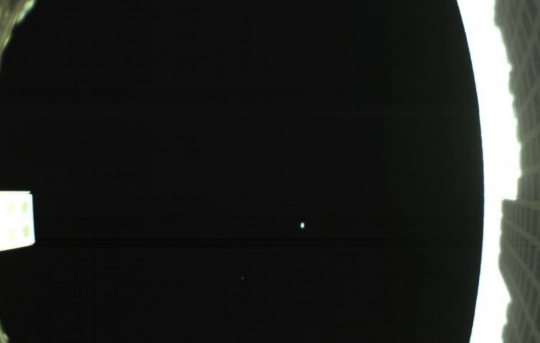Centauri Dreams
Imagining and Planning Interstellar Exploration
Perspective on the View from Out There
Although we’ve seen spectacular images from deep space with the help of Voyager, New Horizons and numerous other spacecraft, the view from 1 million kilometers out can still put our world in perspective. Below is what a CubeSat called Mars Cube One (MarCO-B), one of a pair of such diminutive spacecraft, saw from that distance as it turned its camera back toward Earth. At the sides of the image you can see bits of the thermal blanket, the high-gain antenna feed and the HGA itself at the right, but in the center is the place we call home, the Earth-Moon system. You may want to zoom in to see the Moon better.
Image: The first image captured by one of NASA’s Mars Cube One (MarCO) CubeSats. The image, which shows both the CubeSat’s unfolded high-gain antenna at right and the Earth and its moon in the center, was acquired by MarCO-B on May 9. Credit: NASA/JPL-Caltech.
I’ve been keeping an eye on the MarCO CubeSats because they are the first of their type to be sent into deep space. The intention is to use them to relay data about the InSight Mars lander; the CubeSats are a technology demonstration that will help us clarify their future uses. The science will be carried out by InSight itself (Interior Investigations Using Seismic Investigations, Geodesy and Heat Transport) on the Martian surface, so this CubeSat image is a bonus.
It’s also a fine perspective changer, of the sort the space program has provided us throughout its history. So many people have seen and been moved by the famous Bill Anders photo of Earthrise from Apollo 8 that I almost don’t have to show it, but then again, how could I not, given that it still puts a shiver up my spine? The image was taken on December 24, 1968, a Christmas Eve that was immortalized by the Apollo 8 crew’s reading of the opening lines of Genesis. The crew also had this bit of banter about the acquisition of the image:
Anders: Oh my God! Look at that picture over there! There’s the Earth coming up. Wow, is that pretty.
Borman: Hey, don’t take that, it’s not scheduled. (joking)
Anders: (laughs) You got a color film, Jim? Hand me that roll of color quick, would you…
Lovell: Oh man, that’s great!

Great indeed. The Earthrise image has been declared “the most influential environmental photograph ever taken” (by photographer Galen Rowell) and inspired countless people including this writer, who had an enormous poster of it on his bedroom wall. Perspectives normally shift slowly, but in the era of space photography, perspective jumps can be startling, offering the planet the opportunity to see itself with fresh eyes. The reprocessed 1966 photo from the robotic Lunar Orbiter 1 wasn’t released by NASA until 2008, but even in its black and white form (and at lower original quality), it could also have triggered such a shift.
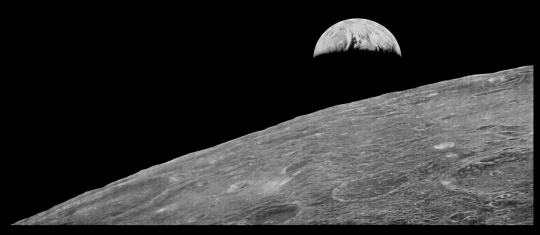
Image: This restored old image of Earth was released by NASA in 2008. The Lunar Orbiter 1 spacecraft took the iconic photograph of Earth rising above the lunar surface in 1966. Using refurbished machinery and modern digital technology, NASA produced the image at a much higher resolution than was possible when it was originally taken. Credit: NASA, Lunar Orbiter Image Recovery Project.
The thing about space exploration is that the wonders just keep coming, which invariably gets me to New Horizons and the image that provided my most recent perspective jump. Here we’re seeing the beautiful blue of Pluto’s haze layer through the New Horizons Multispectral Visible Imaging Camera (MVIC).
But of course the perspective jolt is in realizing that we’re seeing Pluto from behind. The Voyagers have traveled much farther than this, but not past Pluto, which for me had always been symbolic of the system’s ‘edge.’ To be looking at sunlight coming through its atmosphere from behind after the close flyby was an almost surreal experience.

Image: The high-altitude haze at Pluto is thought to be similar in nature to that seen at Saturn’s moon Titan. The source of both hazes likely involves sunlight-initiated chemical reactions of nitrogen and methane, leading to relatively small, soot-like particles (called tholins) that grow as they settle toward the surface. This image was generated by software that combines information from blue, red and near-infrared images to replicate the color a human eye would perceive as closely as possible. Credit: NASA/JHUAPL/SwRI.
One more perspective changer takes us back toward Earth. It’s from the Deep Impact spacecraft, now re-purposed as EPOXI, a double-mission comprised of the Deep Impact Extended Investigation (DIXI) and Extrasolar Planet Observation and Characterization (EPOCh). Here again we’re looking at Earth and its Moon in a series of images showing the passage of the Moon between us and our planet. You’ll find more on EPOCh especially in the archives here, for the spacecraft has been used not only to study exoplanets but also to examine the Earth to help characterize planets like ours for future missions.
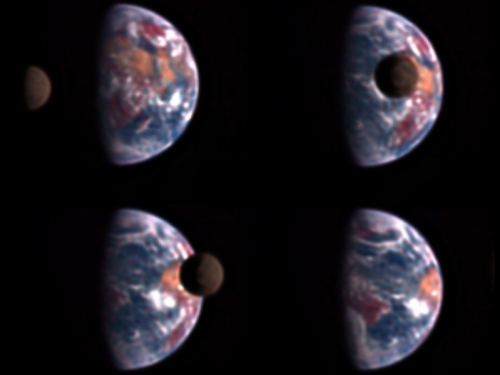
Image: Four images from a sequence of photos taken by the Deep Impact spacecraft when it was 50 million km from the Earth. Africa is at right. Notice how much darker the moon is compared to Earth. It reflects only as much light as a fresh asphalt road. Credit: Donald J. Lindler, Sigma Space Corporation, GSFC, Univ. Maryland, EPOCh/DIXI Science Teams.
But you knew the medievalist in me couldn’t resist pulling a far older reference on perspective into the picture. Below is one of the earliest paintings to use linear perspective, the work of Florentine artist known as Masaccio (1401-1428). It may not seem to have much in common with space missions, but consider this: The development of perspective in painting was the emergence of a far more realistic depiction of people amidst buildings and landscapes, a style that would be known as Florentine Realism and would fundamentally change visual art. How we look at ourselves in the world influences the values and character of a civilization.

Images cause us to see ourselves with fresh eyes, and in the spectacular imagery of our space missions, we get a gut-check on our place in the universe. Some people say that the famous ‘pale blue dot’ image made us realize how insignificant we are, but I have a much different take. The Voyager image below, taken when Voyager was 6 billion kilometers from home, shows Earth as a speck barely visible in the brown band to the right. When I look at it, what I see is that we are a species that was able to get out there and look back upon its own home world.
Going to other planets, going to the stars — there is nothing inevitable in any of this. These are choices we make, within the context of our values and our science. Images like these remind us how momentous our choices are.
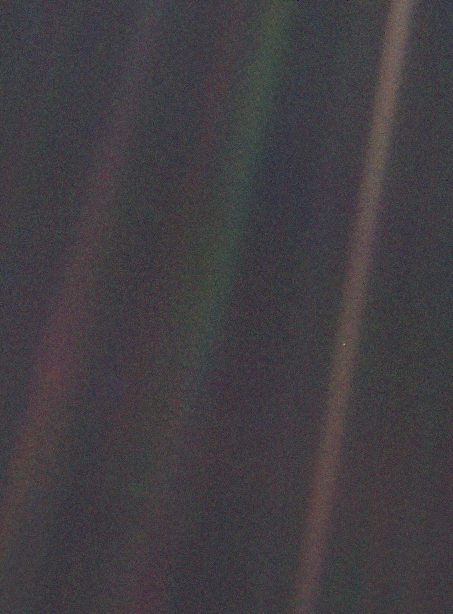
Image: This narrow-angle color image of the Earth, dubbed ‘Pale Blue Dot’, is a part of the first ever ‘portrait’ of the solar system taken by Voyager 1. The spacecraft acquired a total of 60 frames for a mosaic of the solar system from a distance of more than 6 billion kilometers from Earth and about 32 degrees above the ecliptic. From Voyager’s great distance Earth is a mere point of light, less than the size of a picture element even in the narrow-angle camera. Earth was a crescent only 0.12 pixel in size. Coincidentally, Earth lies right in the center of one of the scattered light rays resulting from taking the image so close to the sun. This blown-up image of the Earth was taken through three color filters – violet, blue and green – and recombined to produce the color image. The background features in the image are artifacts resulting from the magnification. Credit: NASA/JPL-Caltech.
The MarCO team also has the ‘pale blue dot’ in mind, pointing to its own Earth/Moon image:
“Consider it our homage to Voyager,” said Andy Klesh, MarCO’s chief engineer at NASA’s Jet Propulsion Laboratory, Pasadena, California. JPL built the CubeSats and leads the MarCO mission. “CubeSats have never gone this far into space before, so it’s a big milestone. Both our CubeSats are healthy and functioning properly. We’re looking forward to seeing them travel even farther.”
The pale blue dot fills me with humility but also an exhilarating sense of the human drive to explore. And that brings me back to New Horizons, now closing on the Kuiper Belt Object MU69. ‘Ultima Thule,’ as it is known by the New Horizons team, is only about 30 kilometers in diameter and seems to be a close binary. On January 1, 2019 we will have a flyby of this object, the farthest ever to be visited by a spacecraft. Who knows what perspective changes that imagery may trigger?

Galileo Evidence for Plumes on Europa
Once again we take advantage of older databanks to tease out new information. Europa is the case in point this morning, with Galileo data — magnetic field and plasma wave observations from 1997 — being brought in as evidence for a water vapor plume rising from the surface. The Galileo flyby took the craft closer than 400 kilometers, where a brief spike in plasma density was detected along with a concurrent decrease in magnetic field magnitude and a bend in the direction of the field. The data are consistent with a plume interacting with Jupiter’s plasma outflow, and support earlier Hubble indications of possible plumes on the moon.
We have no firm measurement of the thickness of Europa’s ice, but if we are to get to that fascinating ocean now known to exist below the surface, we have to contend with penetrating it. Plumes from the interior would be helpful indeed, as Enceladus showed us at Saturn. Flying a spacecraft through a plume lets us measure its ingredients and sample the ocean below. So this new work, which has just been published in Nature Astronomy, offers the prospect of plume sampling via close flyby for upcoming missions like Europa Clipper.

Image: Artist’s illustration of Jupiter and Europa (in the foreground) with the Galileo spacecraft after its pass through a plume erupting from Europa’s surface. A new computer simulation gives us an idea of how the magnetic field interacted with a plume. The magnetic field lines (depicted in blue) show how the plume interacts with the ambient flow of Jovian plasma. The red colors on the lines show more dense areas of plasma. Credit: NASA/JPL-Caltech/Univ. of Michigan.
As it happens, lead author Xianzhe Jia (University of Michigan) is co-investigator for two instruments designed for Europa Clipper, and it was another member of the Europa Clipper science team, Melissa McGrath (SETI Institute) who prompted the deeper dive into Galileo data, inspired by the intriguing observations from Hubble. The space telescope was operating at the far edge of its capabilities, leaving the prospect of Europan plumes ambiguous, but the location of one of the Hubble ‘plumes’ turned out to be useful. Says Jia:
“One of the locations she mentioned rang a bell. Galileo actually did a flyby of that location, and it was the closest one we ever had. We realized we had to go back. We needed to see whether there was anything in the data that could tell us whether or not there was a plume.”
What Hubble observed at the site appeared to rise some 200 kilometers above the surface of Europa, consistent with the Galileo data. As the paper notes, Galileo acquired magnetomer data on eight targeted passes of Europa during its eight years in Jovian orbit, but only two of these passes came closer to the surface than 400 kilometers, a height at which a plume might give off both a plasma and magnetic field signature. As the paper notes:
Both passes crossed the trailing hemisphere of Europa (E12 near the equator and E26 at high southern latitude) and recorded short time-duration, large-amplitude perturbations accompanied by a sharp decrease of the field magnitude near closest approach. A previous study of the potential effect of plumes on Europa’s plasma interaction suggested that the magnetic perturbations during the E26 flyby could be associated with atmospheric inhomogeneity resulting from a plume. Here, we show that a localized signature in the MAG data acquired on Galileo’s closest encounter with Europa (E12 flyby) is fully consistent with the perturbations expected if the spacecraft crossed a plume rising above the nearby surface.

Image: This is Figure 3 from the paper. Caption: Location of the modeled plume on Europa’s surface. a,b, Perspectives from a longitude of 270°?W (a) and from above the northern pole (b). The surface features shown on the sphere were extracted from a global map of Europa compiled by the United States Geological Survey. The cyan iso-surface of constant neutral density illustrates the shape and location of the modelled plume, and the magenta traces show the Galileo trajectory. The green ellipse in a indicates the location of a putative plume imaged by Hubble. Credit: Jia et al.
Certainly the experience we gained with Cassini at Enceladus has helped to investigate this phenomenon, for we know that material within the plumes, once ionized, has effects on the magnetic field similar to the bend in the field observed in the Galileo data. The spacecraft’s plasma wave spectrometer likewise proved useful, examining the interactions caused by charged particles above the Europan surface, and clearly demonstrating a spike in intensity.
Using 3D modeling tools developed by his team, Jia was able to simulate the interactions of plasma with bodies like Europa, producing simulated plumes that matched the Galileo data and were consistent with what Hubble had revealed.
“There now seem to be too many lines of evidence to dismiss plumes at Europa,” says Robert Pappalardo, Europa Clipper project scientist at NASA’s Jet Propulsion Laboratory in Pasadena, California. “This result makes the plumes seem to be much more real and, for me, is a tipping point. These are no longer uncertain blips on a faraway image.”
We can hope that Europa Clipper will get off as early as mid-2022, for its low-altitude flybys should allow us to sample dust particles and frozen liquid, a glimpse into the moon’s dark interior. As you would imagine, these findings have the Europa mission team examining orbital trajectories that will allow such measurements to be taken. The Europan plumes certainly aren’t as visible as the plumes of Enceladus, but if what Galileo encountered really was a plume during its eight-year mission, then plumes must be occurring on relatively short timescales.
The paper is Jia et al., “Evidence of a plume on Europa from Galileo magnetic and plasma wave signatures,” published online at Nature Astronomy 14 May 2018 (full text).

SETI: An Alternate Strategy
How would an advanced society communicate its history and values to the stars? Bill St. Arnaud argues that just as we can uncover our own history through careful analysis of archaeological sites, so SETI might uncover traces of ETI cultures in the form of signals that take advantage of natural astrophysical processes. Read on for more on an idea Bill first broached in a Centauri Dreams post called Virtual Von Neumann Probes. A consultant and research engineer, Bill’s work has involved everything from charging methods for electric vehicles to next generation Internet networks. But his interest in SETI continues to mesh with his expertise in networking in this examination of a novel way to speak from the deep past.
by Bill St. Arnaud

To date most SETI research has focused on the assumption that an advanced extra- terrestrial society will want to “communicate” with similar beings throughout the universe. But it is my belief that given the vast distances and time that communication via a “communications channel” even if it is one way, such as optical or radio frequency transmissions will be impractical.
Current SETI searches assume that an advanced civilization will use extremely powerful omni-directional transmitters or highly directional and focused signals targeted at our solar system. The challenge with either approach is the fact that successful one-way communication between intelligent species is the dependency on the “L” term in the Drake equation. L represents the length of time for which such civilizations release detectable signals into space. If L is relatively short then possibility of two separate intelligent civilizations being coincident in time to send and receive a signal is very small. So even though there may have been many intelligent civilizations we will probably never be aware of their existence.
Given these constraints I suggest instead that we look for extra-terrestrial intelligence in a similar way we searched for signs of intelligence on earth prior to the modern age. We cannot hope to communicate to prehistoric man, but we know that intelligent beings existed on earth thousands of years ago through archaeological evidence such as cave paintings, pyramids, monuments, etc.
More recently societies have been burying time capsules for future generations to discover and hopefully marvel at our accomplishments and perspectives of the future. Indeed several spacecraft have included time capsules to be hopefully discovered by humans or extra-terrestrial intelligent beings in the far future. Part of the Apollo 11 Lunar Module, still on the moon, includes a plaque showing the arrangement of the Earth’s continents in 1969. The LAGEOS satellite (which will re-enter the atmosphere in 8.4 million years) contains a plaque showing the arrangement of the Earth’s continents in the past, present, and future. Pioneer 10 and Pioneer 11 both contain plaques that give pictorial information about their time and place of origin. The two Voyager spacecraft each contain a golden record that contains pictures and sounds of Earth, along with symbolic directions for playing the record and data detailing the location of Earth.
The understandable challenge of physical time capsules is the probability of locating and/or discovering these time capsules by future generations or aliens. Given the vast distances of space it is highly improbable that these time capsules will ever be discovered by any kind of intelligent being.
So rather than deploying physical time capsules can we think of a way of deploying electromagnetic time capsules made from self amplifying or self re-generating optical and RF signals that propagate forever and are easily discoverable and locatable? SETI researchers, in the past, have often speculated on self replicating robots that could travel to distant planets and recreate themselves by using local materials, but the complexity of such a device boggles the mind. Self amplifying and regenerating electromagnetic signals on the other hand would conceivably be much easier to deploy and possibly be achievable with current technology.
Self amplification and regenerating signals could use natural physical process such as gravitational lensing, stellar corona pump amplification, orbital angular momentum and other techniques to propagate electromagnetic signals indefinitely. But rather than being a straight line propagation in the direction of the original signal, self amplification and regenerated signals may propagate in all sorts of random directions depending on the physical properties of the amplification and regeneration process itself. As such the signals may be bouncing around the galaxy from one star to another in no particular predetermined direction.
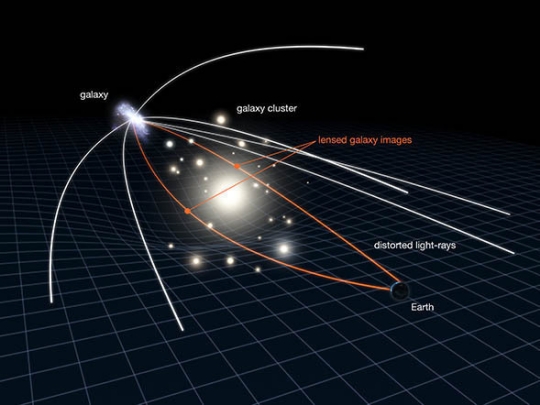
Image: An example of one kind of naturally occuring gravitational lensing, in this case involving galactic clusters. Lensing clusters are clusters of elliptical galaxies whose gravity is so strong that they bend the light from the galaxies behind them. This produces distorted, and often multiple images of the background galaxy. But despite this distortion, gravitational lenses allow for greatly improved observations as the gravity bends the lights path towards Hubble, amplifying the light and making otherwise invisible objects observable. Credit: JPL.
Given that they depend on natural physical processes for amplification and regeneration the originating transmission does not to be that powerful or directional. It is conceivable that low power transmissions are that all is required to launch a self amplifying and regenerating electromagnetic signal. The signals may also be in a part of the spectrum that is not usually commonly assumed for interstellar transmission but rather exist in parts of the spectrum associated with the physical amplification and regeneration process.
There are a host of problems with current interstellar electromagnetic signaling such as attenuation, dispersion, group delay, etc etc. Given these limitations how could we hope to deploy a self replicating optical signal that will maintain its integrity over the vast distances and time of space?
One intriguing possible solution is using gravitational lenses to refocus and amplify a interstellar electromagnetic signal. In an interesting post called The Gravitational Lens and Communications, Paul Gilster quotes the work of Italian physicist Claudio Maccone, who explains that a ‘Sun-Alpha Centauri direct radio bridge exploiting both the two gravitational lenses, this minimum transmitted power is incredibly… small! Actually it just equals less than 10-4 watts, i.e. one tenth of a milliwatt is enough to have perfect communication between the Sun and Alpha Cen through two 12-meter FOCAL spacecraft antennas.`
One should also note that a gravitational lens acts like a lens with a gradient refractive index which also collimate and reduce electromagnetic dispersion.
Other possible mechanisms for self replicating signals include RF Orbital Angular Momentum (OAM), quantum entanglement and using stellar corona as pump amplifiers. As an example see the recent post about solar corona masering. I am sure there are other possible candidates. I challenge the reader of this missive to think of other ways of creating self replicating electromagnetic time capsules.
If we can come up with a plausible mechanism for deploying self replicating optical/rf time capsules the next obvious step would be to see if we can detect any such phenomena in our local interstellar region.
Instead of searching for communications signal from an extraterrestrial intelligent civilization we should perhaps instead look for “archaeological” evidence of their existence with the most likely candidate being a easily discoverable self replicating electromagnetic time capsule.
If you have any suggestions or comments, or think I am completely nuts please feel free to contact me at Bill.st.arnaud@gmail.com

The Habitable Zone: The Impact of Methane
The definition of a habitable zone is under constant refinement, an important line of research as we choose which exoplanets to focus on in our search for life. Centauri Dreams regular Alex Tolley today looks at the question as it involves the presence of methane. With planetary warming already known to vary depending on the spectral type of the host star, we now learn that the presence of methane can produce thermal inversions and surface cooling on M-star exoplanets, impacting the outer limits of the habitable zone. The work of Ramses Ramirez (Tokyo Institute of Technology) and Lisa Kaltenegger (Carl Sagan Institute, Cornell University), the paper also suggests a possible biosignature near the outer habitable zone edge of hotter stars, one of several results that Alex explores in today’s essay.
by Alex Tolley

Alien world – still from 2001: A Space Odyssey. Credit: Metro-Goldwyn-Mayer (MGM)
As noted in previous posts on biosignatures, especially in regards to life prior to photosynthetic oxygenation of the atmosphere, methane (CH4) is a gas that appears early due to prokaryotic methanogens producing it at rates far higher than geological processes and sustaining its presence despite the chemical destruction. The presence of CH4 in a primordial N2-CO2-H2O atmosphere has been suggested as a component of a biosignature (Detecting Early Life on Exoplanets).
Which leads to the obvious question. As CH4 is a potent greenhouse gas, does it impact the size of the habitable zone (HZ), particularly its outer edge, which is usually defined by the greenhouse gas CO2? This is exactly the question that Ramirez and Kaltenegger try to answer in a new paper. Using their prior approach of assuming a rocky, Earth-like world around different star types, they approach the problem of modeling the effect of the star’s emission on the planet’s atmosphere with varying mixing ratios of CH4 from 10-100,000 ppm.
The authors have previously shown that the spectra of the star impact the warming of a planet [4, 5]. As the spectrum shifts towards the red, the warming efficiency increases. Because CH4, unlike CO2 and H2O, has strong absorption in both the infrared (IR) and near-infrared (NIR), this spectral shift has an even more pronounced effect when CH4 is an atmospheric component gas. For exoplanets with CH4 in their atmospheres around cool stars, the absorption occurs in the upper atmosphere, causing a thermal inversion and cooling the surface. Figure 1 shows the atmospheric temperature profile with altitude when 1% (10,000 ppm) of CH4 is added to a 3 bar atmosphere of CO2 for three star types: F0, our G-type sun, and M3. For both the F0 and G stars, the CH4 increases the surface temperature.20-30K. However, for the M3 star, the surface temperature is reduced by 30K as much of the energy is already absorbed at high altitude. Unlike most atmospheres, exoplanets around M-stars with a CH4 component have a temperature inversion. This has a direct effect on the outer limit of the HZ.



Figure 1. Changes in temperature profiles for a 3 bar CO2 atmosphere (S/So = 0.33) for a model planet with a surface pressure of about 4 bar orbiting a) an F0, b) a solar-analog, and c) an M3 host star when adding 1% (10,000 ppm) CH4. A temperature inversion forms for all three model planets when CH4 is added to the atmosphere. The surface temperature increases when 1% CH4 is added for the planet orbiting the F0 (18K) and solar analog (29K), but decreases for the planet orbiting an M3 star (31K).
Intuitively we expect that CH4 should extend the outer edge of the HZ for the F0 and G type stars as less energy is required to maintain a surface temperature above freezing (273K). For K3 stars and hotter, their model adding CH4 does indeed extend the HZ’s outer edge, quite substantially, while the inner edge remains fairly similar in distance from the star. However, because of the reduced surface temperature of the cooler stars, especially the ubiquitous M-types, CH4 reduces the range of the HZ, pulling the outer edge of the HZ closer to the star.
Figure 2 shows the effect of different mixing ratios of CH4 on the effective stellar flux (SEFF) needed to maintain a surface temperature above freezing against stellar types. Some cooler star exoplanets at the outer edges of their HZ zones are shown, indicating that some may have frozen surfaces if they have CH4 as an atmospheric gas component.

Figure 2. The effect of adding methane to the outer edge of the classical HZ. Stellar effective temperature versus the effective stellar flux (SEFF) for the outer limits of the Habitable Zone. The traditional outer HZ limit, the CO2 maximum greenhouse limit (dashed), is shown along with the empirical outer edge (solid black) and outer edge limits (solid blue) containing various amounts of CH4: 10 ppm (triangle), 1% (square), and fCH4 = 0.1 x fCO2. Some confirmed planets near the outer edge are included with error bars displayed.
The presence of CH4, therefore, has an impact on target exoplanet life. For Earth, CH4 might help explain the problem of the young, faint sun. When the earth was formed, the lower luminosity of the sun was insufficient to raise the surface temperature above freezing, yet life clearly evolved quite early. CH4 emission by methanogens during the Archean eon may have warmed the Earth’s surface sufficiently to have allowed liquid oceans and prokaryotes to evolve, and certainly ensured that an ice-free surface allowed photosynthetic blue-green bacteria to harvest solar energy.
Because CH4 extends the outer edge of the HZ for our sun, calculations suggest that early Mars was within the HZ if it had a dense CO2 atmosphere with a CH4 component. If so, this would support the theory of liquid seas on its surface and possibility that life also emerged to produce the needed CH4, or hydrogen (H2) to maintain its warmth as the atmosphere initially waned [6]. As the atmosphere was eventually largely stripped, the surface cooled and the seas froze to become the subsurface glaciers and frozen aquifers that we detect today, as well as the polar ice caps of frozen water and CO2. Whether life still exists below the surface is unknown, although there are tantalizing hints that just maybe methanogens are the source of the detected CH4 in the atmosphere, rather than geologic emissions.
The authors suggest that due to the far higher biogenic source of CH4, exoplanets around hotter stars on the edge of their HZ’s with detectable CH4 might well be evidence that they are living worlds. This is further bolstered by their model that shows CH4 levels can create a sort of Gaian “Daisy World” [2] where the surface temperature is maintained by processes that stabilize CH4 levels. Figure [3] shows this. Point P2 is stable as a declining CH4 level increases the surface temperature, increasing the CH4, while levels above that point reduce the temperature and reduce the emitted CH4.

Figure 3. Proposed “Daisyworld” scenario for planets at the outer edge of the methane HZ with CH4 in their atmospheres orbiting hotter (~A – G class) stars. The curved lines illustrate the effect that the CH4/CO2 ratio has on surface temperature whereas the straight lines depict the effect that
temperature has on the CH4/CO2 ratio (adapted from Domagal-Goldman et al. 2008).
However, this is not the case with M-star exoplanets. The authors’ model suggests that for these worlds, the increased CH4 cools the planet resulting in a freezing surface which might well extinguish the development of life. Therefore on a planet at the outer edge of the HZ evolving methanogens will cool, freezing the surface. Life would be forced to retreat to oceanic vents and the lithosphere, precluding the emergence of photosynthesis, and energetic motile, multicellular life.
Another question also remains unanswered. M-star dwarf exoplanets orbit so close to their star that they are likely tidally locked. As we have seen previously, such warm wet worlds are also likely to have high cloud cover and therefore higher albedos [4]. Do those factors influence the results of this model? The authors hint that these conditions do matter quite significantly and will be explored in their next paper. Stay tuned!
References
1. Ramses M. Ramirez, and Lisa Kaltenegger, 2018, “A Methane Extension to the Classical Habitable Zone,” The Astrophysical Journal Vol. 858, No. 2 (7 May 2018). Abstract.
2. Andrew J. Watson, James E. Lovelock, 1983, “Biological homeostasis of the global environment: the parable of Daisyworld”, Tellus B, vol. 35B, no. 4, pp. 284-289 (abstract).
3. H. Lammer, J. H. Bredehöft, A. Coustenis, M. L. Khodachenko, L. Kaltenegger, O. Grasset, D. Prieur, F. Raulin, P. Ehrenfreund, M. Yamauchi, J.-E. Wahlund, J.-M. Grießmeier, G. Stangl, C. S. Cockell, Yu. N. Kulikov, J. L. Grenfell, H. Rauer, 2009, “What makes a planet habitable?”, The Astronomy and Astrophysics Review, vol. 17, no. 2, pp. 181-249 (abstract).
4. Sarah Rugheimer, Lisa Kaltenegger “Spectra of Earth-like Planets Through Geological Evolution Around FGKM Stars”, The Astrophysical Journal 854(1). Abstract.
5. Ramses M. Ramirez. 2014 “Terrestrial planets under extreme radiative forcings: applications to habitable zones, early Mars, and a high-co2 Earth.” Ph.D. thesis. Pennsylvania State University (abstract).
6. Ramses M. Ramirez, & Lisa Kaltenegger 2016. “Habitable Zones of Post-Main Sequence Stars.” The Astrophysical Journal, 823(1), 6 (abstract).

The Seasons of Exoplanetary Life
Looking for biological products in planetary atmospheres is how we’ll first study exoplanetary life, assuming it exists. The tools for characterizing atmospheres have already developed to the point that we are examining the gases surrounding some ‘hot Jupiters,’ and even talking about the movement of clouds — exoplanet meteorology — on giant worlds. The hope is that TESS will find targets that we can then investigate with new space telescopes.
The way forward is exciting, but my guess is that as we start looking into the atmospheres of transiting planets around nearby red dwarfs, the most accessible targets in the near future, we’re going to find ourselves awash in controversy. Did we just find oxygen? Maybe we’re on the way to a biosignature detection, but then again, ultraviolet radiation can break down atmospheric water to produce oxygen. For that matter, UV can split carbon dioxide molecules.
What about methane? Abiotic methane from geothermal activity on the surface could account for that, and there are other production mechanisms as well. Ideally, we’ll find gases that are many orders of magnitude out of thermochemical equilibrium with the planet’s atmosphere. A combination, say, of an oxidizing gas like oxygen and a reducing gas like methane — these shouldn’t co-exist without some replenishing source — is suggestive of metabolism. But these are going to be tough detections, and we’re likely to see huge controversy over just how significant the early findings are.
We have to start somewhere, but bear in mind that life on Earth produces thousands of different biosignature gases, most of which are in such small quantities that they accumulate little in the atmosphere. Most are produced for reasons specific to the organism. Sara Seager is doing brilliant work compiling all the molecules that exist in a planetary atmosphere under conditions of temperature and pressure similar to the Earth. This is by way of compiling a comprehensive list of biosignature gases and the false positive possibilities that accompany them.
Image: Sara Seager’s volume Exoplanet Atmospheres (Princeton University Press, 2010) is a core contribution to this developing work.
All of which gets us to an interesting new take on biosignature detection out of the University of California at Riverside. What lead author Stephanie Olson and team have produced is what is being described as the first quantitative framework for dynamic biosignatures based on seasonal changes. The idea here is straightforward: Axial tilt creates weather changes and also changes in atmospheric composition. Thus a northern hemisphere summer shows increased plant growth, hence lower levels of carbon dioxide and higher levels of oxygen.
“Atmospheric seasonality is a promising biosignature because it is biologically modulated on Earth and is likely to occur on other inhabited worlds,” Olson says. “Inferring life based on seasonality wouldn’t require a detailed understanding of alien biochemistry because it arises as a biological response to seasonal changes in the environment, rather than as a consequence of a specific biological activity that might be unique to the Earth.”
We can also keep in mind that extremely elliptical orbits could produce seasonality on extrasolar planets in the same way that axial tilt does, which could widen the range of planets under future investigation. Homing in on the seasonal formation and loss of oxygen, carbon dioxide and methane and their detection through spectroscopy, the authors also extended the work to include planets with low oxygen content, where fluctuations on a world like the early Earth might be detectable. Here, ozone (O3) turns out to be an easier marker to identify through seasonal variability than oxygen (O2).
That’s a useful finding, because after all, a planet like the early Earth would have shown a markedly different atmospheric composition than the blue and green world of today. Start with hydrogen and helium in an early atmosphere and add in water vapor, carbon dioxide and sulphur from volcanic eruptions. The process is stochastic (i.e., randomly determined); when does oxygen appear? Ozone? Ideally, we’d like to see a world with water vapor, oxygen, ozone and carbon dioxide because these are strong absorbers that show up well in planetary spectra.
I notice that the atmosphere of ‘early Earths’ is something that co-author Timothy Lyons, also at UC-Riverside and director of the Alternative Earths Astrobiology Center, emphasizes:
“We are particularly excited about the prospect of characterizing oxygen fluctuations at the low levels we would expect to find on an early version of Earth,” Lyons says. “Seasonal variations as revealed by ozone would be most readily detectable on a planet like Earth was billions of years ago, when most life was still microscopic and ocean dwelling.”
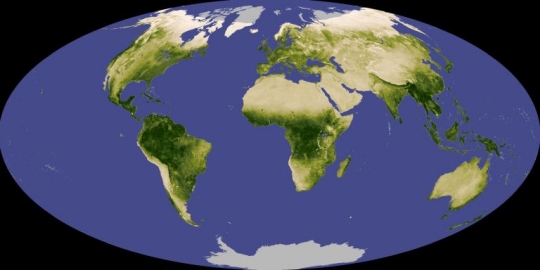
Image: Satellites monitor how ‘greenness’ changes with Earth’s seasons. UC-Riverside scientists are studying the accompanying changes in atmospheric composition as a marker for life on distant planets. Credit: NASA.
In any case, I fall back on my prediction. We are going to start getting exoplanet atmospheric data around rocky worlds orbiting red dwarfs within the next decade or so, and our results will be ambiguous at best. Erwin Schrödinger said that living matter ‘avoids the decay into equilibrium’ by fighting entropy, which is why finding out of balance gases co-existing would be highly significant. But while oxygen is comparatively easy to detect, trace methane is not.
I expect a battle royal to break out over the significance of such gases in the amounts we find them, and the quest to filter out all the false positives may take us many years.
The paper is Olson et al., “Atmospheric Seasonality as an Exoplanet Biosignature,” Astrophysical Journal Letters Vol. 858, No. 2 (9 May 2018). Abstract. On Sara Seager’s work on potential biosignature gases, see “Toward a List of Molecules as Potential Biosignature Gases for the Search for Life on Exoplanets and Applications to Terrestrial Biochemistry,” Astrobiology. June 2016, 16(6): 465-485 (abstract).

Asteroid at the Edge
Our current depictions of conditions in the early Solar System involve titanic change, with the giant planets moving inward and then outward, creating gravitational havoc and scattering inner system objects in all directions. Such disruptions doubtless happen in other infant planetary systems and because of them, we can predict a large population of so-called ‘rogue’ planets that move through the galaxy dissociated from any star. Closer to home, there may well be small objects kicked into extreme orbits that bear evidence of these migrations.
The ‘grand tack’ hypothesis sees Jupiter forming at around 3.5 AU, well in from its current 5.2 AU orbital position, with migration all the way in to 1.5 AU before a reversal of course and movement outward to its current position. Imagine Jupiter plowing through the asteroid belt — twice — and the chaos of its passage, producing a wide scattering in asteroid orbital inclinations and eccentricities. The ‘Nice model’ likewise involves gas giant migration, and has been invoked to explain the Late Heavy Bombardment as well as populations like the Kuiper Belt.
Now we learn of an observation that may teach us something about these events. A Kuiper Belt Object tagged 2004 EW95 is carbon-rich, typical of other carbonaceous asteroids in having a dark surface distinctive of carbon’s presence. This KBO, in other words, looks to be much like a main belt asteroid of the C-type, but it’s found at the edge of the system. The unusual spectral details turned up in work from Tom Seccull (Queen’s University Belfast) and colleagues, who used data from multiple instruments at the European Southern Observatory’s Very Large Telescope.

Image: The early days of our Solar System were a tempestuous time. Theoretical models of this period predict that after the gas giants formed they rampaged through the Solar System, ejecting small rocky bodies from the inner system to far-flung orbits at great distances from the Sun. Credit: ESO.
2004 EW95 had already been studied by Wesley Fraser, a member of Seccull’s team at Belfast, and it was in those observations, using the Hubble instrument, that it became clear that the object’s reflectance spectrum differed from the Kuiper Belt Objects around it. Whereas their spectra tend to be all but featureless, 2004 EW95 stood out. That merited a closer look through the VLT, producing an unusual observing challenge.
Imagine trying to study a dark object a mere 300 kilometers across as it moves through its orbit four billion kilometers from Earth. Co-author Thomas Puzia (Pontificia Universidad Católica de Chile) likens the task to observing a mountain of coal against a pitch black sky. The VLT’s X-Shooter spectrograph and FORS2 spectrograph and imager offered the precision needed. The paper calls the reflectance spectrum found here ‘unusual’ and states that it is:
…exhibiting a large drop in its near-UV reflectance and a broad shallow optical absorption feature centered at ?700 nm, which is detected at greater than 4? significance. These features, confirmed through multiple epochs of spectral photometry and spectroscopy, have respectively been associated with ferric oxides and phyllosilicates. The spectrum bears striking resemblance to those of some C-type asteroids, suggesting that 2004 EW95 may share a common origin with those objects.
The presence of ferric oxides and phyllosilicates marks 2004 EW95 as a kind of KBO that had never been found before, implying an origin far closer to the Sun. The phyllosilicate feature in the spectra, say the authors, points to significant heating in this object’s history, possibly radiogenic or the result of either solar irradiation or one or more collisions.
Each of these two features has been independently observed by two separate instruments, and are present in the reported reflectance spectra regardless of which of our solar calibrator targets, or which of two separate spectral extraction techniques, were used in our data reduction.
Thus 2004 EW95 takes us from a prediction made by two dynamical models of the early Solar System and fulfills that prediction in an actual KBO. The ‘grand tack’ model assumes that the early migrations of Jupiter and Saturn would have scattered carbonaceous asteroids that had formed near them and flung them into the outer Solar System, and we would thus expect that 2005 EW95 is not alone in the Kuiper Belt. From the paper:
The striking similarity between 2004 EW95 and certain C-type [carbonaceous] asteroids points to the plausible idea that 2004 EW95 shares a common origin with these objects. Taken together, the spectroscopic similarity to C-type asteroids and the orbital properties of 2004 EW95 are consistent with the idea that this object may have formed near Jupiter among the primordial C-type asteroids (Walsh et al. 2011) and was subsequently emplaced into the Kuiper Belt by the migrating planets.
So we have an object whose spectrum resembles those of primitive carbonaceous asteroids orbiting the Sun in a stable mean motion resonance with Neptune. Its orbit is highly inclined and eccentric, likely the result of dynamical instability and consistent with gas giant migration.
The paper is Seccull et al., ”2004 EW95: A Phyllosilicate-bearing Carbonaceous Asteroid in the Kuiper Belt,” Astrophysical Journal Letters 855, L26 (10 March 2018). Preprint / full text.

